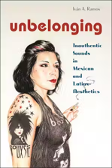
In his book Unbelonging. Inauthentic Sounds in Mexican and Latinx Aesthetics, performance studies scholar Iván A. Ramos asks the following question: What do Mexicanidad and Latinidad sound like? Ramos uses this question to launch his study of Mexican and Latina/o musicians and artists who fall outside of racialized expectations of Latin American soundings. Ramos proposes the concept of ‘unbelonging’ to describe how the musicians and artists he works with “are constantly rendered illegible to the fantasy of national and ethnic belonging because of their embrace of sonic forms that are heard as an affective removal from Mexicanidad or Latinidad.” Throughout the book, Ramos explores a wide range of ‘illegible’ sounds and communities: Mexican sound artists, Chicana punks and metalheads, and Latina/o fans of British rock. By prioritizing the sounds and people that neoliberal narratives of national belonging fail to explain, Ramos effectively critiques frameworks of hybridity and identity often used to examine Mexican and Latina/o communities.
A central distinction in Ramos’s book is the contrast between belonging and unbelonging, between art forms that fuse and others that refuse to mix. In Chapter One, Ramos contrasts the history of visual art and sound art in Mexico City, arguing that sound art provides a means for artists to escape dominant narratives of Mexican nationalism exemplified through visual art. In Chapter Two, he juxtaposes the genre of rock en español with the genres of punk and metal. He argues that while rock en español serves as the perfect hybrid genre, punk and metal refuse to abide by this framework, thereby rupturing narratives of what Mexicans should sound like. In Chapter Three, Ramos contrasts mainstream Latina/o music in the US with the contributions of Chicana punk musicians. He argues that while the Chicana lesbian punk has become a figure of public fascination, the actual role of these women in punk has often been erased or misunderstood. In Chapter Four and the related Coda, Ramos compares the original Latina/o fanbase of British rock musician Morrissey with more recent Mexican-Morrissey fusion music. Through these various case studies, Ramos demonstrates the limitations of a hybridity framework to make sense of these communities that defy fusion entirely. For a similar reason, identity-focused frameworks fail to encapsulate how Ramos’s collaborators frequently break from assumed racial and musical norms.
The concept of piracy and bootlegs forms another key part of Ramos’s theory. Ramos contributes to previous research on musical piracy by examining bootleg objects and people through the concept of unbelonging. He highlights intentionally ugly or inaccessible sounds and the role they play in the lives of his collaborators. These sounds include the sonic and material disintegration of a record made of ice, the scream of the lesbian Chicana punk, and the distorted sound of the heavy metal guitar. These small moments of rupture connect to larger narratives of unbelonging that deviate from national narratives of progress as well as of the nuclear family. Instead, Ramos’s collaborators form their own “utopias of annihilation” and “fantasies of dissolution” as they create community and find escape through the very sounds that others hear as violent and antisocial.
Unbelonging also emphasizes how these outsider musicians and artists do not actively choose the illegibility or unbelonging that emerges through their musical preferences. Instead, their artistic expression originates from a position of unbelonging, one created by economic and political factors that push them to the margins of society. This framing challenges existing theories about belonging and marginalization that assume an intentional rejection of mainstream norms. Ramos also pushes back against identity-centered research approaches, instead focusing on dynamic processes of belonging/unbelonging as well as the aesthetic elements that accompany particular roles and moments. The artists Ramos works with often do not intend to make direct political statements and some specifically define their work as apolitical. Ramos’s analysis therefore challenges us to think beyond the usual frameworks of assigning political intentionality and meaning to art, which often subsumes this art into the narratives of national belonging it aims to break from.
Despite the challenges of being an ‘unbelonging’ subject, the artists that Ramos describes do not lack community. Alternative socialities and friendships develop in contrast to national narratives of belonging through shared practices of listening. In Chapter Four, Latina/o Morrissey fans bond through the shared affective experiences of depression and melancholy. In Chapter Two, alternative queer socialities emerge through feminist punk and metal collectives. In Chapter Three, Chicana punk friendships provide escape from the role of the mother that Chicana women are often forced to serve in the nuclear Latinx family in addition to within queer Latinx communities. These alternative forms of connection and the sonic forms that underlie them serve as survival mechanisms for these marginalized artists.The book closes on a rather pessimistic note that, as Ramos notes, fits with the book’s focus of negativity as a form of belonging. This closing scene takes place at a concert by a Morrissey cover band that attempts to fuse Mexican music traditions with Morrissey’s music. Ramos sees this fusion as an attempt at belonging, and therefore a failure of the unbelonging that historically labeled Latina/o Morrissey fans as outcasts and misfits. He laments how without fail, neoliberalism finds ways to incorporate once radical forms of expression into more legible and “acceptable” formats. However, Ramos remains hopeful that “sometime again—maybe not now, but in the not-too-distant future—we will need to reject promises of belonging that while appealing to inclusiveness thrive by excluding certain subjects.” He hopes that readers of his book can see “the potential joys of welcoming exclusion” amid forces always pushing us towards an inclusion that in practice leaves many people and communities on the outside.

